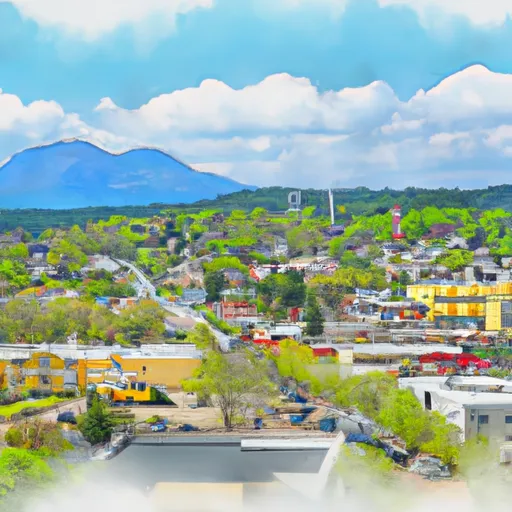-
 Snoflo Premium
Snoflo Premium
Get unlimited access to all our content
With no Ad interruptions! - Start Your Free Trial Login with existing account
Warm-Springs
Eden Index
Climate
8.0
•
Recreation
2.1
•
Community
0.8
•
Safeguard
4.1/10

Warm Springs is a charming town located in Meriwether County, Georgia. The climate in Warm Springs can be described as a humid subtropical climate with hot, humid summers and mild winters. Summers are typically long and hot, with temperatures often reaching the high 80s and low 90s Fahrenheit. Winters are generally mild, with average temperatures ranging from the 40s to the 60s.
The hydrology constituents in Warm Springs are largely influenced by its namesake, the natural warm springs found in the area. These springs are a result of underground water flowing through deep rock formations, which then emerge at the surface with a warm temperature. The water in these springs contains minerals such as calcium, magnesium, and sulfur, which are believed to have therapeutic qualities.
As for outdoor recreation opportunities, Warm Springs offers various activities for nature enthusiasts. Roosevelt State Park, located nearby, provides opportunities for hiking, camping, fishing, and picnicking. The park boasts beautiful trails that wind through forests and along picturesque streams. Warm Springs also offers opportunities for boating and swimming in the nearby Roosevelt Lake. With its pleasant climate and natural beauty, Warm Springs is a perfect destination for those seeking outdoor adventures.
What is the Eden Index?
The Snoflo Eden Index serves as a comprehensive rating system for regions, evaluating their desirability through a holistic assessment of climate health, outdoor recreation opportunities, and natural disaster risk, acknowledging the profound impact of these factors on livability and well-being.
Climate Health Indicator (CHI): 8.0
Warm-Springs receives approximately
1246mm of rain per year,
with humidity levels near 86%
and air temperatures averaging around
17°C.
Warm-Springs has a plant hardyness factor of
8, meaning
plants and agriculture in this region tend to thrive here all year round.
By considering the ideal temperature range, reliable water supplies, clean air, and stable seasonal rain or snowpacks, the Climate Health Indicator (CHI) underscores the significance of a healthy climate as the foundation for quality living.
A healthy climate is paramount for ensuring a high quality of life and livability in a region, fostering both physical well-being and environmental harmony. This can be characterized by ideal temperatures, reliable access to water supplies, clean air, and consistent seasonal rain or snowpacks.
Weather Forecast
Streamflow Conditions
Apalachicola
Area Rivers
Apalachicola
Snowpack Depths
Apalachicola
Reservoir Storage Capacity
Apalachicola
Groundwater Levels
Recreational Opportunity Index (ROI): 2.1
The Recreational Opportunity Index (ROI) recognizes the value of outdoor recreational options, such as parks, hiking trails, camping sites, and fishing spots, while acknowledging that climate plays a pivotal role in ensuring the comfort and consistency of these experiences.
Access to outdoor recreational opportunities, encompassing activities such as parks, hiking, camping, and fishing, is crucial for overall well-being, and the climate plays a pivotal role in enabling and enhancing these experiences, ensuring that individuals can engage in nature-based activities comfortably and consistently.
Camping Areas
| Campground | Campsites | Reservations | Toilets | Showers | Elevation |
|---|---|---|---|---|---|
| Riverbend County Park | None | 219 ft | |||
| Clark Creek South - Allatoona Lake | None | 858 ft | |||
| Eastbank - Lake Seminole | 40 | 87 ft | |||
| River Junction - Lake Seminole | 16 | 199 ft | |||
| Cochran Mill County Park | None | 937 ft | |||
| Clark Creek North - Allatoona Lake | None | 896 ft | |||
| F.D. Roosevelt State Park | None | 1,272 ft | |||
| Dobbins Lakeside Military | None | 1,079 ft | |||
| Chattahoochee City Park | None | 96 ft | |||
| McKinney - Allatoona Lake | None | 889 ft |
Nearby Ski Areas
Catastrophe Safeguard Index (CSI):
The Catastrophe Safeguard Index (CSI) recognizes that natural disaster risk, encompassing floods, fires, hurricanes, and tornadoes, can drastically affect safety and the overall appeal of an area.
The level of natural disaster risk in a region significantly affects safety and the overall livability, with climate change amplifying these risks by potentially increasing the frequency and intensity of events like floods, fires, hurricanes, and tornadoes, thereby posing substantial challenges to community resilience and well-being.
Community Resilience Indicator (CRI): 0.8
The Community Resilience Indicator (CRI) recognizes that education, healthcare, and socioeconomics are crucial to the well-being of a region. The CRI acknowledges the profound impact of these elements on residents' overall quality of life. By evaluating educational resources, healthcare accessibility, and economic inclusivity, the index captures the essential aspects that contribute to a thriving community, fostering resident satisfaction, equity, and social cohesion.

